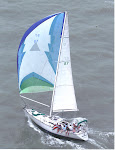One of the joys of having out of town company is being able to visit the old hometown's tourist traps with new eyes. Kathy and Robert Briscoe were visiting for 5 days. This was too short a visit to plan a sailing adventure so we hung out in Elizabeth Harbor which is the actual name of the vast road stead that cruisers refer to as George Town. The road stead is about a mile wide by 5 miles long. Elizabeth Harbor is bounded on the NE by Stocking Island and on the SW by the very large Great Exuma Island. Elizabeth Island, Guana Cay and Fowl Cay trail off to the SE. More about Fowl Cay later in the post. Conch Cut is the northwestern entrance and North Cut is the southeastern entrance (go figure about North Cut being off to the south).
During the visit we walked up and down the dusty main street. I learned that this is actually the Queen's Highway although no one ever calls it that. We visited the straw market and the better souvenir shops. We eat cracked conch and drank Kalik beer at Eddie's. Readers should translate cracked conch as deep fat fried conch which has been pounded vigorously. Please never order this dish in the USA or anywhere except the Bahamas. Without knowledgeable preparation conch is awful, but in the hands of a Bahamian it can be heavenly. I have never had any better than at Eddie's Edgewater Restaurant.
We walked the trails of Stocking Island. We looked for shells on the spectacular beaches of Stocking Island. We dallied at the legendary beach bar 'Chat and Chill' on Volley Ball Beach. But the fact is that the Sands Bar on on Hamburger Beach serves a much better hamburger.
However, what the Briscoes were interested in the most was good snorkeling. White Pepper usually snorkels at a little reef just south of Sand Dollar Beach, but it is tame fare. For more adventure we took the boat to an anchorage off Guana Cay (which is open but the weather was settled). The next morning we set off in the dink for Fowl Cay about a mile away. Fowl Cay is a small, uninhabited island near North Cut. We pulled the dink, Habenero, up onto a deserted isolated beach. There we had a light picnic lunch while waiting for slack water. Finally the time came to swim around the southern corner of Fowl Cay to the most amazing reef I have ever seen. It was only about 200 yards long and in about 4 feet of water. The reef was aflame with yellow and purple coral of many shapes and sizes. There were fish everywhere. It was like swimming in a well kept aquarium. Robert, looking under a ledge, found 18 empty conch shells. His theory was that this was the nest of an octopus who has dragged these small conch to his home and ate them at his leisure. We all quickly started to look for conch shells, and within an hour the four of us had rounded up 33 nearly matched perfect specimens of conch shells each about 3 inches long—quite a treasure. The next morning we took Habenero about half a mile north to explore the reef between Guana Cay and Elizabeth Island. There is a lot of reef here. I estimate a tall man could probably walk between the islands at low tide if walking on coral were allowed. However, this reef while better than average just could not compare with Fowl Cay. Unfortunately, it was here that White Pepper's usually reliable Olympus underwater camera leaked. It has never come back to life and many spectacular underwater shots were lost.
Many cruisers and scientist all over the world report that coral reefs are dying and threatened. I suppose this is true as I rarely see great coral in my travels. But at least in one small small corner of the Bahamas, Fowl Cay, there is a really great coral reef within in easy reach.























